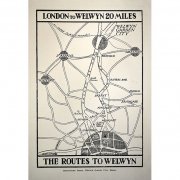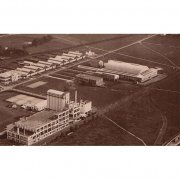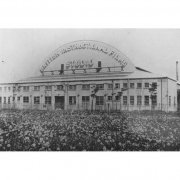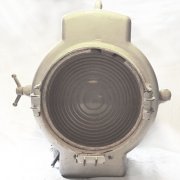Designed by Louis de Soissons and built by Dawnays in 16 weeks the Welwyn Studios opened in 1928 at Broadwater Road, Welwyn Garden City, Herts, for British Instructional Films (BIF). Producer & director Bruce Woolfe was Managing Director and the Studios specialised in geographical & historical documentary and nature films including the 'Secrets of Nature' series before Woolfe began to focus on feature films including Anthony Asquith's A Cottage on Dartmoor (1929). This was one of the first 'sound films' although some dialogue and music were added later. The 1927 Cinematograph Films Act required British cinemas to show a quota of British films and inadvertently led to many household names making early cinematic contributions at Welwyn, such as Ann Todd, Ralph Richardson, Margaret Lockwood, Bela Lugosi and Alfred Hitchcock. A larger sound stage was added to Welwyn Studios in 1930. The Studios were absorbed by John Maxwell's British International Pictures (BIP) in 1931. It was predominately used to accommodate overflow productions from Elstree and hired out by companies such as Gaumont-British who made WWI drama I Was A Spy in 1933. A new production company, Welwyn Studios Ltd., was set up in 1935. Maxwell switched main production to Welwyn Studios in 1939 since, unlike Elstree, it was not requisitioned in the war. Alfred Hitchcock, among others, returned to Welwyn Studios to make propaganda films to aid the war effort. Later taken over by Maxwell's Associated British Picture Corporation (ABPC) Welwyn Studios was used by various production companies during the 1940s. Brighton Rock (1947), I Live in Grosvenor Square (1945) and Piccadilly Incident (1946) were made there. With dated facilities commercial pressures forced ABPC to sell Welwyn Studios to tobacco company Ardath in late 1950, ending the three-stage studios that had produced over 70 films, contributed to the war effort, introduced audiences to many cinematic stars and had been the home of many classic films, still enjoyed today. The Trust is very grateful to pupils and staff from Onslow St Audrey's School's Heritage Society who undertook the challenge of finding this information as part of the 'Where Do You Think We Worked?' project.








Welwyn Film Studios - set for I Was A Spy. Bernard C remembers he & his friend liked "to go over the other side of the railway line where the Welwyn Film Studios operated the main railway line and on the other side there was a building which after the War became Polycell I think but in our days it was a film studios" They hid themselves in the grass and watched the crew filming I was a Spy... "it was about the First World War and there were explosions and all sorts of things going on!"
Chris B told us "they used the workings in the gravel pits for the trench scenes and in those days (because of course they didnt have the special effects that weve got now) the explosions used to be carried out on the scene, sort of thing, and so the parents used to have to take their young children away from that area of Longcroft Green because of the noise."
Tony T worked as an extra "they wanted lots of extras and they brought them in by the train load from memory it was a war film and then other extras could come as well so I probably got 1 shilling for a days work". Image from Hertfordshire Archives & Local Studies

